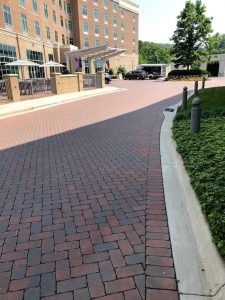The University of Florida Institute of Food and Agricultural Sciences (UF/IFAS) Extension is working with local communities to educate and encourage sustainable water runoff solutions amidst Florida’s rapid growth.
Low-impact development (LID) is a design approach for real estate developers to manage future stormwater runoff needs. When used effectively, rain gardens, permeable pavement, rain harvesting and other LID methods can often improve nutrient removal, use a smaller footprint and provide additional benefits when compared to a traditional stormwater pond system.
“UF/IFAS Extension works with developers and local government to provide resources on LID and help them understand the benefits of these practices,” said Eban Bean, UF/IFAS agricultural and biological engineering researcher. “Once people start to understand how easy it is to implement this practice and that it can be a cost savings, they see why it makes a lot of sense to move in this direction.”
LID techniques aim to mimic how the water moves through the landscape before being developed.

A statewide study conducted by the Florida Department of Environmental Protection found that stormwater ponds are not as effective at preventing nutrients from entering surface and groundwater as originally thought. Instead of the assumed metric of 80 percent removal of nitrogen and phosphorous, less than 50 percent of nitrogen is removed in stormwater ponds, and conditions for removing 80 percent of phosphorus are rarely achieved.
“We have over 75,000 storm water ponds across the state of Florida,” Bean said. “We need a better approach to manage stormwater runoff.”
Different LID techniques include permeable pavements which allow water to drain through the surface rapidly. The pavement is strong enough to withstand driving and parking and enables stormwater management right at the source, replacing areas that would typically create runoff.

Bioretention, or rain gardens, are another technique where areas of slightly lower elevation are distributed around a landscape to capture a small amount of water that will infiltrate the soil. This allows plants to take up water, nutrients and pollutants and retain them at the site instead of flowing into a storm system, pond or other water body downstream.
Rainwater harvesting systems are another common practice used within a LID system. Cisterns and rainwater harvesting barrels capture runoff from rooftops that is then used for irrigation or other non-potable water uses.
Across the state, LID is gaining traction but adoption of the sustainable practice has been slow, according to UF/IFAS Extension Osceola County agent Krista Stump.
“LID is not very well known amongst homeowners and residents,” Stump said. “In the future, we want LID to be included in the county’s land development code. In order to do that, decision-makers need to see that homeowners and residents are interested and invested in more sustainable practices.”
Osceola County is the fifth-fastest growing county in the United States, according to the U.S. census, with a 35-percent population increase between 2010 and 2018. The need for sustainable practices with the increased development is high, Stump said.

“Florida is defined by its water, but we have a lot of water issues,” Bean said. “LID implementation is one way we can encourage development that is sustainable for the future to preserve the paradise of Florida we all enjoy.”
On Nov. 6, UF/IFAS Extension Osceola County will hold its first LID Symposium.
“Anyone from local government and policymakers, developers, engineers, builders and even homeowner’s association representatives would benefit from attending the symposium,” Stump said. “If you are considering implementing LID, you could benefit from attending.”
“One of the greatest barriers that planners, engineers and decisionmakers express is that they are worried about the regulatory requirements,” Stump said. “Right now for stormwater management, you have to prove that you have a plan in place that will adequately address the amount of runoff that is occurring. We are hoping attendees can understand how LID can be successfully incorporated into those plans and correct any misperceptions.”
Attendees will learn what the LID approach means and perspectives from the regulatory community including water management districts and local governments around the area. Attendees will leave with a better understanding of why LID is needed.
“We need a paradigm shift in how we develop and manage stormwater for a more sustainable future for water resources in Florida,” Bean said. “And we plan to impart them with that information.”
For more information on LID in Osceola County, visit the free LID Symposium on Nov. 6. CEU credits are available for planners. To register, visit eventbrite.com/e/low-impact-development-symposium-tickets-73864802613.
 0
0
